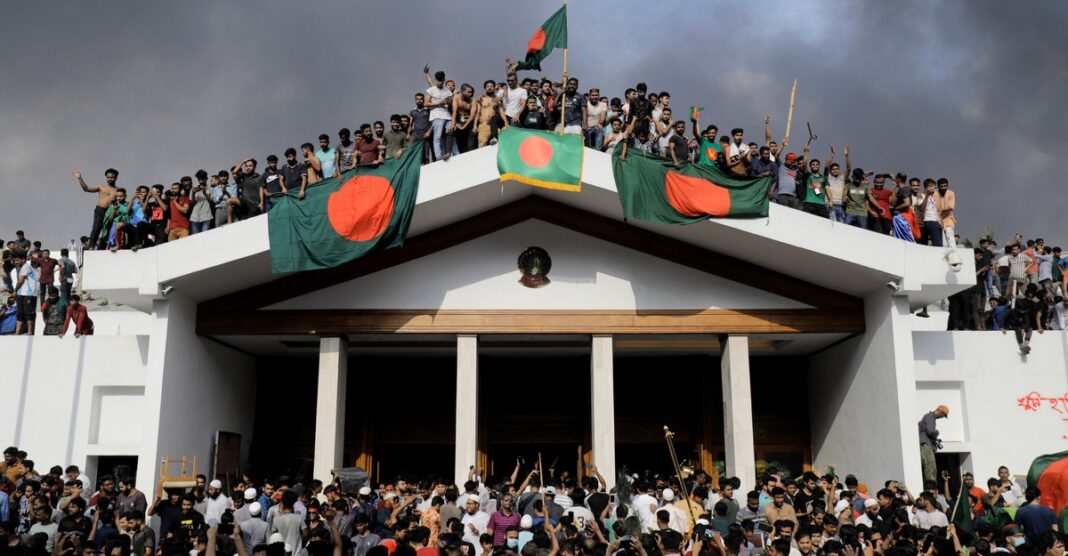Abu Sayed stood with his arms outstretched, holding nothing but a stick, when Bangladeshi police fired their shotguns. A video from July shows the 25-year-old student facing a wall of officers in riot gear. Tear gas has cleared out the other protesters, but Sayed stays, baring his chest as police shoot warning rounds at his feet. More shots ring out; he staggers, then falls to the hot cement. He died before reaching a hospital.
Sayed’s killing galvanized the Bangladeshi people, marking the moment when “everything started to fall apart” for the government, Ali Riaz, a Bangladeshi political scientist at Illinois State University, told me. The protests multiplied, led by a group of students that came to be known as the Anti-Discrimination Movement. Within days, state authorities imposed a national curfew and cut off telecommunications in the country. Within two weeks, police and paramilitary forces had killed hundreds of demonstrators. Within a month, protesters marched on the capital, forcing the nation’s leader, Prime Minister Sheikh Hasina, to resign and flee to India. In her stead, a makeshift government has emerged, run in part by the same students who toppled the old one.
The proximate cause of the protests was the reinstatement of a government-job quota that massively favored members of the ruling party, the Awami League. Like many working-class students in Bangladesh, Sayed went to college in hopes of finding work in the civil service. His parents and siblings scrounged money for his tuition, betting that his postgraduate employment would provide for them in return. But in June, the supreme court of Bangladesh reinstalled the quota, reversing a decision from 2018, and slashing his chances. Sayed was one of 400,000 graduates in his year competing for a mere 3,000 jobs. They weren’t the only ones upset by the quota; the government’s apparent favoritism inspired Bangladeshis of all professions, classes, and ages to protest.
For much of her 15-year reign, Hasina and the Awami League relied on the quota to stock the government with loyalists and shore up her rule. Bangladesh first instituted the system after its liberation from Pakistani forces in 1971, setting aside one-third of its civil-service jobs for the descendants of those who fought in the war for independence. (Hasina was the most obvious beneficiary; her father, Sheikh Mujibur Rahman, led the independence movement. Challenging the quota meant, in one sense, challenging Hasina’s right to rule.) Because the Awami League was associated with the war effort, the quota disproportionately benefited students affiliated with the party.
As protests intensified following the court’s decision in June, the government’s response grew more draconian. Hasina deployed the nation’s Border Guard—a paramilitary group that typically patrols the country’s frontiers with India and Myanmar—and implemented a shoot-on-sight order for anyone who violated the curfew. Demonstrations turned violent. Tanks roamed city streets. Authorities beat and killed scores of unarmed students. Aid groups have reported that dozens of children died, too, including a 6-year-old girl struck by a stray bullet while playing on the roof of her apartment building.
The government’s brutality proved to be a strategic misstep. Instead of subduing the protesters, repression strengthened their numbers. “Ten thousand were suppressed, and 20,000 showed up,” Mahfuz Anam, the editor of the leading national newspaper, The Daily Star, told me. “Twenty thousand dispersed, and 100,000 showed up.” On August 3, student organizers demanded Hasina’s resignation. Two days later, hundreds of thousands of Bangladeshis marched on her official residence as she escaped in a helicopter.
The students quickly installed an interim government and named Muhammad Yunus, a Nobel laureate and critic of Hasina, as its head. Backed by an advisory board that includes student leaders, he’s indicated that he has much larger ambitions than simply stewarding Bangladesh through to a new election. Earlier this month, Yunus announced the creation of several commissions focused on reforming institutions including the judiciary, electoral system, and police.
“After 15 years of autocracy, the entire body of the country is rotten,” Shafqat Munir, a Bangladeshi security expert, told me. “Limb by limb, the interim government will have to repair the country.” How much Yunus will be able to accomplish remains unclear, but he appears determined to unwind Hasina’s legacy. If he has any success, the students who ousted her will play a key part.
On a humid evening in late August, I stood with Ashrefa Khatun, a student leader in the Anti-Discrimination Movement, amid towers of water bottles and donated clothes. Days earlier, flash flooding had overrun a city in southeast Bangladesh, and Khatun—the daughter of a rickshaw puller and garment worker—was suddenly coordinating national relief efforts. She is one of many students who have taken on roles such as policing traffic, protecting sites of worship, cleaning streets, and, more recently, responding to natural disasters.
Khatun attributes the success of the Anti-Discrimination Movement to savvy organizing. Students across multiple universities used social media to recruit one another and arrange demonstrations, including highway blockades. They circulated memes—many derived from Marvel movies—tallying each day’s wins and losses. When the government shut down the internet in response to its Gen Z adversaries, the students switched to offline texting apps, such as Bridgefy, that allowed them to continue communicating during the blackout. Nazifa Hannat, an undergraduate who helped coordinate across the schools, told me that even students enrolled in private universities—like she is—felt compelled to join the movement, despite the fact that their superior job prospects insulated them from the effects of the quota. “For us, it wasn’t about the quotas,” she told me. “We started to protest injustice.” When private-university students joined the movement en masse, street protests grew too large for the government to manage. More and more, it resorted to violence. Khatun quickly discovered the importance of recruiting female students: Police, she found, were less likely to use violence when enough women attended a demonstration.
In addition to social media, the movement embraced an older mode of protest—public art. Near the University of Dhaka, the largest public university in the country, I approached a group of students painting a work that read LIVE FREE in English, Bangla, and sign language. One of the artists was Quazi Islam, the president of a student club that promotes disability awareness. He told me that propaganda from the Awami League and its student wing, the Bangladesh Chhatra League, once dominated campus walls, whereas “we had to get permission from proctors or the BCL students to put something up.” Now, he told me, he is “reclaiming the walls that belong to the students and the country.”
The art began appearing as early as June and serves today as a record of the summer’s events. A wall in the university’s amphitheater displays a quote from a widely viewed video in which a police officer tells his commander, “When I shoot one, only one dies. The rest don’t scatter.” A spray-painted message on a pillar reads The Z in Gen Z stands for zero chance of defeat. Several murals show Abu Sayed facing a bullet.
Many of the student protesters already had firsthand experience with repression. In 2018, an unlicensed bus driver ran over two high-school students on their way home from school, sparking national outrage. Students campaigned for better road safety, but members of the BCL forced them back into their homes. That wasn’t the end of the campaign, though; the students adapted, relying on digital organizing. Many of today’s student leaders are those same schoolchildren from six years ago—including Khatun. The road-safety movement is what inspired her to apply to university in the first place.
Hasina and the Awami League tried every trick they could to subdue the protests. There is no easy way to explain how students persevered and overthrew a 15-year-old regime in less than 60 days. But their achievement offers a clear lesson: Despotism is often more brittle than it seems.



